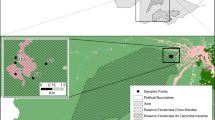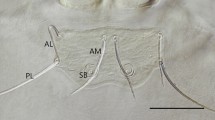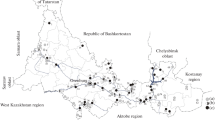Abstract
Studies of mites on bats in the Mexican state Oaxaca are scarce. Our objective was therefore to evaluate the richness, infestation, and specificity of spinturnicid mites on bats in southern Oaxaca, Mexico. Bats were monthly captured from April 2010 to February 2011, in four sites using four mist-nets; also, we visited natural (crevices) and artificial roosts (tunnel). Of each bat we account the number of spinturnicid mites, considering the area of the body where they were collected. Mites were preserved in 70 % ethanol and later they were mounted on microscope slides in Hoyer’s medium. We captured bats of 15 species, of which eight species were infested. We recorded seven spinturnicid mites: five of the genus Periglischrus, one of the genus Cameronieta, and one of the genus Mesoperiglischrus. Periglischrus caligus, P. iheringi, and Periglischrus sp. are new records on Artibeus lituratus, Glossophaga soricina, and G. commissarisi, respectively. More infested bat species were Artibeus jamaicensis (93.8 %), A. lituratus (88.9 %), G. commissarisi and Sturnira parvidens (both 66.7 %). Prevalence of A. jamaicensis and A. lituratus was significantly higher than most other bat species. Although prevalence percentage was high, mean and median intensity were low. Spinturnicid mites were recorded in particular areas of a bat’s body; therefore, they could be an additional tool for the taxonomic identification of bats.
Similar content being viewed by others
References
Altringham JD (2001) Bats: from evolution to conservation, 2nd edn. Oxford University Press, New York
Álvarez T, Álvarez-Castañeda ST, López-Vidal JC (1994) Claves para murciélagos mexicanos. Centro de Investigaciones Biológicas del Noreste, Baja California Sur
Barker SC (1994) Phylogeny and classification origins and evolution of host associations of lice. Int J Parasitol 24:1285–1291
Bassols de Barrera IB (1979) Mesostigmatid ectoparasites of mammals in Mexico. In: Rodríguez JG (ed) Recent advances in acarology, vol 2. Academic Press, New York, pp 475–480
Berry N, O’Connor W, Holderied MW, Jones G (2004) Detection and avoidance of harp traps by echolocating bats. Acta Chiropterol 6:335–346
Byrnes T, Rohde K (1992) Geographical distribution and host specificity of ectoparasite of Australian bream, Acanthopagrus spp. (Sparidae). Folia Parasitol 39:249–264
Fain A (1994) Adaptation, specificity and host-parasite coevolution in mites (Acari). Int J Parasitol 24:1273–1283
Fenton MB, Simmons NB (2014) Bats: a world of science and mystery. The University of Chicago Press, Chicago
Furman DP (1966) The spinturnicid mites of Panama. In: Wenzel RL, Tipton VJ (eds) Ectoparasites of Panama. Field Mus Nat Hist, Chicago, pp 125–166
Gettinger D, Gribel R (1989) Spinturnicidae mites (Gamasida: Spinturnicidae) associated with bats in central Brazil. J Med Entomol 26:491–493
Hall ER (1981) The mammals of North America, vol 1. Wiley, New York
Herrin CS, Tipton VJ (1975) Spinturnicid mites of Venezuela (Acarina: Spinturnicidae). Brigham Young Univ Sci Bull Biol Ser 20:1–72
Hoffmann A (1944a) Un nuevo ácaro parásito de murciélagos. Ann Inst Biol Univ Nac Autón Méx Ser Zool 15:185–189
Hoffmann A (1944b) Periglischrus vargasi n. sp. (Acarina: Parasitidae). Rev Inst Salub Enferm Trop 5:91–96
Hoffmann A (1944c) Ectoparásitos de Murciélagos Mexicanos. MSc thesis, Universidad Nacional Autónoma de México
Hoffmann A, López-Campos G (2000) Biodiversidad de los ácaros en México. Comisión Nacional para el Conocimiento y Uso de la Biodiversidad, México, DF
Hoffmann A, Palacios-Vargas JG, Morales-Malacara JB (1980) Bioecología de la cueva de Ocotitlán, Tepoztlán, Morelos. Fol Entomol Mex 43:21–22
Kingston N, Villa B, Lopez-Forment W (1971) New host and locality records for species of the genera Periglischrus and Cameronieta (Acarina: Spinturnicidae) on bats from Mexico. J Parasitol 57:927–928
Krantz GW (1971) A manual of acarology. Oregon State University, Book Stores Inc, Oregon
Kunz TH, Tidemann CR, Richards GC (1996) Capturing mammals: small volant mammals. In: Wilson DE, Cole FR, Nichols JD, Rudran R, Foster MS (eds) Measuring and monitoring biological diversity: standard methods for mammals. Smithsonian Institution Press, Washington, pp 122–146
Machado-Allison CE (1964) Notas sobre Mesostigmata neotropicales. II. Cuatro nuevas especies de Periglischrus Kolenati, 1857 (Acarina, Spinturnicidae). Rev Soc Mex Hist Nat 25:193–207
Machado-Allison CE (1965) Las especies Venezolanas del género Periglischrus Kolenati 1857. Acta Biol Venez 4:259–348
Marshall AG (1981) The ecology of ectoparasitc insects. Academic Press, London
Medellín RA, Arita HT, Sánchez O (2007) Identificación de los murciélagos de México: clave de campo, 2nd edn. Universidad Nacional Autónoma de México, México, DF
Morales-Malacara JB (1980) Ácaros ectoparásitos de murciélagos en cuevas el estado de Morelos. Fol Entomol Mex 45:70–71
Morales-Malacara JB (1996) Mesostigmatid (Mesostigmata) ectoparasites of bats in Mexico. In: Mitchel R, Horn DJ, Needham GR, Welbourn WC (eds) Acarology IX. Ohio Biological Survey, Columbus, pp 105–108
Morales-Malacara JB (1998) Ácaros Mesostigmata parásitos de murciélagos de México. Dissertation, Universidad Nacional Autónoma de México
Morales-Malacara JB (2001) New morphological analysis of the bat wing mites of the genus Periglischrus (Acari: Spinturnicidae). In: Halliday RB, Walter DE, Proctor HC, Norton RA, Colloff MJ (eds) Acarology: proceedings of the 10th international congress. CSIRO Publishing, Melbourne, pp 185–195
Morales-Malacara JB, Corona-Tinoco M (1994) Acari ectoparasites of Lonchorhina aurita in San Lucas Ojitlan, Oaxaca, Mexico. Bat Res News 35:108
Morales-Malacara JB, Juste J (2002) Two new species of the genus Periglischrus (Acari: Mesostigmata: Spinturnicidae) on two bat species of the genus Tonatia (Chiroptera: Phyllostomidae) from southeastern Mexico, with additional data from Panama. J Med Entomol 39:298–311
Morales-Malacara JB, López-Ortega G (1994) Ectoparasite fauna of Dermanura azteca in Tlaxcala, Mexico. Bat Res News 35:108
Morales-Malacara JB, López-Ortega G (2001) A new species of the genus Periglischrus (Acari: Mesostigmata: Spinturnicidae) on Choeronycteris mexicana (Chiroptera: Phyllostomidae) in Central Mexico. J Med Entomol 38:153–160
Morales-Malacara JB, López-W R (1998) New species of the genus Spinturnix (Acari: Mesostigmata: Spinturnicidae) on Corynorhinus mexicanus (Chiroptera: Vespertilionidae) in Central Mexico. J Med Entomol 35:543–550
Palacios-Vargas JG, Morales-Malacara JB (1983) Biocenosis de algunas cuevas de Morelos. Mém Biospéol 10:163–169
Palacios-Vargas JG, Vázquez I, Morales-Malacara JB (1985) Aspectos faunísticos y ecológicos de la gruta de Juxtlahuaca, Gro., México. Mem Biospeol 12:135–142
Pence DB, Jones JK, Knipping PA (1981) Acari of Antillean bats (Chiroptera). J Med Entomol 18:353–354
Ramírez-Pulido J, González-Ruiz N, Gardner AL, Arroyo-Cabrales J (2014) List of recent land mammals of Mexico, 2014. Spec Publ Mus Texas Tech Univ 63:1–69
Reiczigel J, Rózsa L (2005) Quantitative parasitology. Version 3.0. http://www.zoologia.hu/qp/qp.html. Accessed 1 Dec 2015
Reiczigel J, Abonyi-Tóth Z, Singer J (2008) An exact confidence set for two binomial proportions and exact unconditional confidence intervals for the difference and ratio of proportions. Comput Stat Data Anal 52:5046–5053
Rohde K (1980) Host specificity indices of parasites and their application. Experientia 36:1369–1371
Rudnick A (1960) A revision of the mites of the family Spinturnicidae (Acarina). Univ Calif Publ Entomol 17:157–248
Schnitzler HU, Kalko EVK (1998) How echolocating bats search and find food. In: Kunz TH, Racey PA (eds) Bat biology and conservation. Smithsonian Institution Press, Washington, pp 183–196
Sheeler-Gordon LL, Owen RD (1999) Host tracking or resource tracking? The case of Periglischrus wing mites (Acarina: Spinturnicidae) of leaf-nosed bats (Chiroptera: Phyllostomidae) from Michoacan, Mexico. Acta Zool Mex 76:85–102
Voigt CC, Kelm DH (2006) Host preferences of bat flies: following the bloody path of stable isotopes in a host-parasite food chain. Can J Zool 84:397–403
Webb JP, Loomis RB (1977) Ectoparasites. In: Baker RJ, Jones JK, Carter DC (eds) Biology of bats of the new world family Phyllostomidae. Part II. Special Publication Mus Texas Technical University, vol 13, pp 57–119
Wharton GW (1938) Acarina of Yucatan caves. Carnagie Inst Washington Publ 491:137–152
Whitaker JO, Morales-Malacara JB (2005) Ectoparasites and other associates (ectodytes) of mammals of Mexico. In: Sánchez-Cordero V, Medellín RA (eds) Contribuciones mastozoológicas en homenaje a Bernardo Villa. Instituto de Biología UNAM, Instituto de Ecología UNAM, CONABIO, México, DF, pp 535–666
Whitaker JO, Ritzi CM, Dick CW (2009) Collecting and preserving bat ectoparasites for ecological study. In: Kunz TH (ed) Ecological and behavioral methods for the study of bats, 2nd edn. The Johns Hopkins University Press, Baltimore, pp 806–827
Wolfgang M, Polaco OJ (1985) Notas sobre ectoparásitos de murciélagos. Vet Méx 16:269–271
Acknowledgments
We thank the Ministry of Environment and Natural Resources (SEMARNAT) for the authorization of special collection permits. Also, we thank authorities of the Universidad del Mar, campus Puerto Escondido for the logistic support. Finally, Marilyn Vásquez Cruz provided valuable assistance in the laboratory. Useful comments were provided by two anonymous reviewers.
Author information
Authors and Affiliations
Corresponding author
Rights and permissions
About this article
Cite this article
Colín-Martínez, H., García-Estrada, C. Richness, infestation and specificity of spinturnicid mites (Acari: Spinturnicidae) on bats in southern Oaxaca, Mexico. Exp Appl Acarol 70, 155–164 (2016). https://doi.org/10.1007/s10493-016-0066-x
Received:
Accepted:
Published:
Issue Date:
DOI: https://doi.org/10.1007/s10493-016-0066-x




